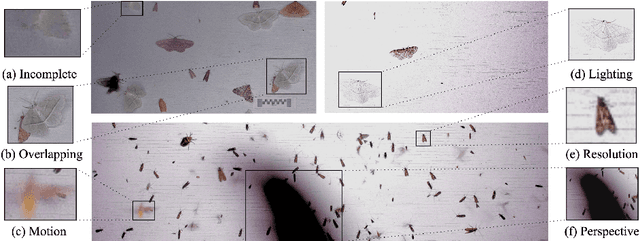Yves Basset
Open-Set Recognition of Novel Species in Biodiversity Monitoring
Mar 03, 2025Abstract:Machine learning is increasingly being applied to facilitate long-term, large-scale biodiversity monitoring. With most species on Earth still undiscovered or poorly documented, species-recognition models are expected to encounter new species during deployment. We introduce Open-Insects, a fine-grained image recognition benchmark dataset for open-set recognition and out-of-distribution detection in biodiversity monitoring. Open-Insects makes it possible to evaluate algorithms for new species detection on several geographical open-set splits with varying difficulty. Furthermore, we present a test set recently collected in the wild with 59 species that are likely new to science. We evaluate a variety of open-set recognition algorithms, including post-hoc methods, training-time regularization, and training with auxiliary data, finding that the simple post-hoc approach of utilizing softmax scores remains a strong baseline. We also demonstrate how to leverage auxiliary data to improve the detection performance when the training dataset is limited. Our results provide timely insights to guide the development of computer vision methods for biodiversity monitoring and species discovery.
Insect Identification in the Wild: The AMI Dataset
Jun 18, 2024



Abstract:Insects represent half of all global biodiversity, yet many of the world's insects are disappearing, with severe implications for ecosystems and agriculture. Despite this crisis, data on insect diversity and abundance remain woefully inadequate, due to the scarcity of human experts and the lack of scalable tools for monitoring. Ecologists have started to adopt camera traps to record and study insects, and have proposed computer vision algorithms as an answer for scalable data processing. However, insect monitoring in the wild poses unique challenges that have not yet been addressed within computer vision, including the combination of long-tailed data, extremely similar classes, and significant distribution shifts. We provide the first large-scale machine learning benchmarks for fine-grained insect recognition, designed to match real-world tasks faced by ecologists. Our contributions include a curated dataset of images from citizen science platforms and museums, and an expert-annotated dataset drawn from automated camera traps across multiple continents, designed to test out-of-distribution generalization under field conditions. We train and evaluate a variety of baseline algorithms and introduce a combination of data augmentation techniques that enhance generalization across geographies and hardware setups. Code and datasets are made publicly available.
 Add to Chrome
Add to Chrome Add to Firefox
Add to Firefox Add to Edge
Add to Edge